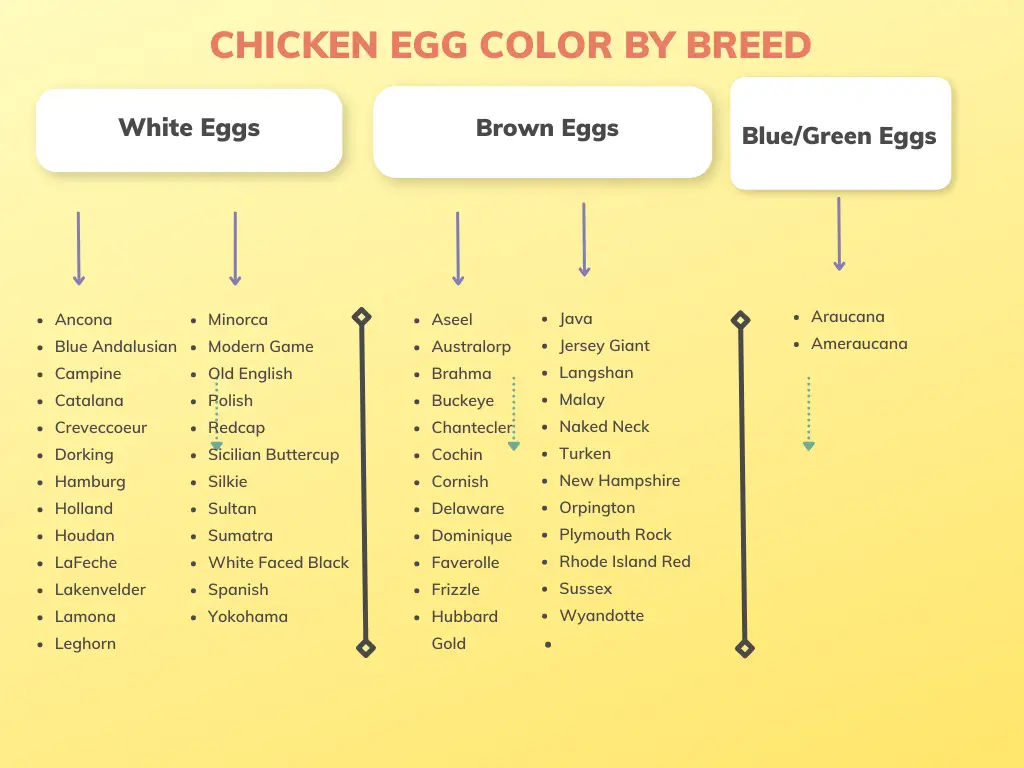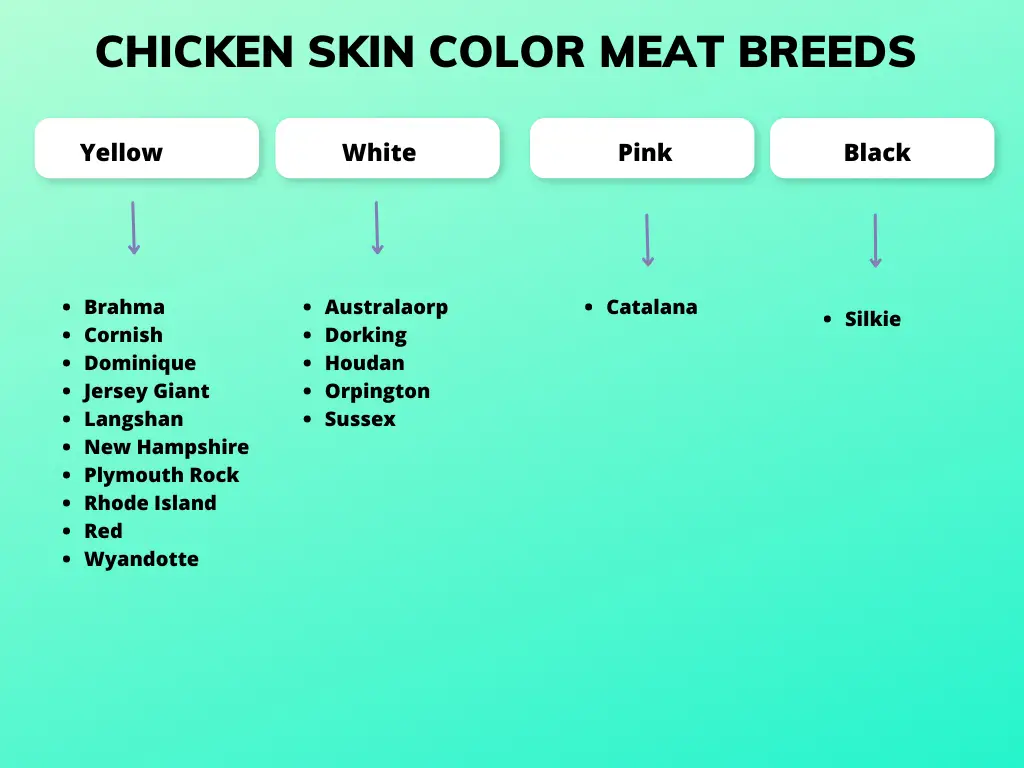Rare Colored Chicken Eggs – Do you want Chickens that Lay Colored Eggs? Grey / Charcoal is one of the rarest color of chickens egg as it can’t be predicted accurately which chickens will produce the charcoal-coloured egg. Below: A charcoal or grey egg. Purple eggs are rare because they are only produced by dark egg layers that produce a heavy bloom on the egg.
If so, there are a few things you need to know before getting started. Chickens that lay colored eggs come in a variety of different colors, including blue, green, and pink. In this blog post, we will discuss the basics of keeping Chickens that Lay Colored Eggs, including what you need to get started and how to care for them.
See Our Other Article also – 5 Factors: How Long do Chickens Lay Eggs? The Surprising Truth About Egg Production
What Color Eggs do Polish Chickens Lay?: A Fun, Informative Guide to Polish Chicken Egg Colors
11 Ways to Make Money by Chicken Farming **2022**
Rare Colored Chicken Eggs? Egg Colors
Rare Colored Chicken Eggs – Chickens that lay colored eggs are not a new phenomenon. In fact, these chickens have been around for centuries. While white-feathered chickens with yellow beaks are the most common, there are actually many different breeds of chickens that lay colored eggs.
Check Out Amazon for Educational Resources for Breeding Chickens
The Araucana, for example, lays blue-green eggs, while the Ameraucana lays olive-colored eggs. The Marans chicken is known for its dark brown eggs, and the double-laced Barnevelder chicken lays rich chocolate brown eggs. Whether you are looking for a unique egg color for your breakfast table or simply want to add some variety to your flock, these colored egg layers are sure to please.

What are chickens that lay colored eggs and where can you find them? (Blue Egg)
Chickens that lay colored eggs are not a separate breed from chickens that lay white eggs. The shell color is determined by the breed of chicken, with some breeds laying white eggs and others laying brown, blue, or even green eggs.
In general, chickens that lay colored eggs are heritage breeds, which means they are well-adapted to their local environment and have been around for centuries. As a result, they are often hardier and healthier than commercial breeds. You can usually find heritage breeds at farmers’ markets or through local breeders. However, because they are less common, they may be more expensive than more conventional chickens.

What do the different colors of eggs mean, and what is their nutritional value compared to regular white eggs?
Chickens that lay white eggs are typically called layer chickens, and they are the most common type of chicken found in the United States. Chickens that lay brown eggs are called brown layers. Brown-egg-laying chickens originated in Asia and Europe.
Brown egg layers are bigger than white egg layers and require more food. As a result, brown eggs typically cost more than white eggs.
When it comes to nutrition, there is no difference between white and brown eggs. Both contain the same amount of protein, fat, and calories. The only difference is in the pigmentation of the eggshell, which is determined by the chicken’s breed. So, whether you choose white or brown eggs, you’re getting the same nutritional value.
Chicken eggs come in a variety of colors, from classic white to shades of brown, blue, and even green. But what do these different colors mean? The egg’s shell is actually composed of two layers: an outer layer of hard calcium carbonate, and an inner layer of a thin membrane.

The color of the eggshell is determined by the types of pigments that are present in the calcium carbonate layer. For example, brown eggs get their color from porphyrins, while blue eggs get their hue from biliverdin.
Despite popular belief, the color of an egg’s shell has no bearing on its nutritional value. In fact, all chicken eggs are virtually identical in terms of their protein, fat, and vitamin content. So whether you choose white or colored eggs, you’ll be getting the same nutritious meal.
What are the Four Factors that determine Egg Color?
Egg color is determined by five factors:
- Breed,
- Nutrition,
- Age,
- Environment
The breed of the chicken will determine the base color of the egg. For example, Araucana chickens lay blue eggs, while Rhode Island Reds lay brown eggs. However, the base color can be lightened or darkened by nutrition, age, environment, and employer.
Nutrition affects egg color because pigments are absorbed from the chicken’s food and deposited in the shell. Age also plays a role in egg color because as a chicken gets older, its shell becomes thicker and less porous, resulting in a darker egg.
The environment can affect egg color because different types of environmental stress (such as extreme cold or heat) can cause a chicken’s body to produce more or less pigment. Finally, employers can influence egg color by artificially manipulating a chicken’s diet or environment. For example, some commercial egg producers use light-colored feed to produce white eggs.
As you can see, there are many factors that go into determining the color of an egg. While most eggs are either white or brown, there is a wide variety of colors that can be found in nature – all thanks to the amazing chicken!
Can Certain Breeds Lay Eggs of Different Colors? (Lay Blue Egg)
Some chicken breeds are known for laying eggs of different colors. The most common type of colored egg is the blue egg, which is laid by the Araucana chicken. Araucanas are a relatively rare breed, and they are not widely available commercially.
However, there are some other chicken breeds that also lay colored eggs. The Easter Egger is a popular breed that can lay green, blue, or pink eggs. Ameraucanas and Marans are two other breeds that are known for their colored eggs. While most chickens lay brown eggs, these special breeds lay colorful eggs that can add excitement to your breakfast table.
Are there any drawbacks to raising chickens that lay colored eggs, or are they just as easy to care for as traditional white egg-laying hens?
When it comes to raising chickens, there are many different factors to consider. One important decision is whether to raise chickens that lay traditional white eggs or those that lay colored eggs. While there are some benefits to raising chickens that lay colored eggs, there are also a few drawbacks to consider.
First of all, colored egg-laying chickens tend to be less productive than their white egg-laying counterparts.
They also require more food and water, and they may not be as resistant to disease. As a result, they can be more expensive to care for. However, many people find the beauty of colored eggs to be worth the extra effort. In the end, the decision of which type of chicken to raise is a personal one.
While chickens that lay colored eggs are just as easy to care for as traditional white egg-laying hens, there are a few drawbacks to raising them. First of all, colored eggs are often more expensive than white eggs.
This is because they are considered to be a novelty item and therefore fetch a higher price. Secondly, colored eggs are more delicate than white eggs and are more likely to crack during the incubation process. As a result, they have a lower hatch rate than white eggs.
Finally, colored egg-laying hens tend to be less productive than white egg-laying hens and their eggs often have a shorter shelf life. However, many people believe that the beauty of colored eggs outweighs these drawbacks.
How Much do Chickens that Lay Colored Eggs Cost Compared to Regular Hens?
Chickens that lay colored eggs typically cost more than regular hens. The reason for this is that they are less common and therefore considered a specialty item. However, the price difference is usually not dramatic – usually only a few dollars more per chicken.
In addition, the cost of feed and care is the same for both types of chickens, so the overall cost of raising colored egg-laying chickens is not significantly different from regular hens.
Ultimately, the decision of which type of chicken to raise comes down to personal preference. Some people prefer the novelty of colored eggs, while others find that the extra cost is not worth it.
On average, chickens that lay colored eggs cost about 20 percent more than regular hens. This is because they are less common and require more specialized care. Chickens that lay colored eggs typically have a higher feed intake and require more space per bird.
They also have a higher mortality rate, which drives up the cost of production. As a result, consumers can expect to pay a premium for colored eggs. However, many find the colorful eggs to be worth the extra cost.
In addition to being visually striking, colored eggs often have a deeper flavor than white ones. For many people, this makes them a worthwhile investment for their kitchen.
Are There any Special Feed Requirements for these Colored Egg Chickens?
No, there are no special feed requirements for Colored Egg Chickens. However, they do require a higher protein diet than most chickens due to their rapid growth rate and the need to produce eggs. A good quality chicken feed will provide the necessary nutrients for Colored Egg Chickens.
It is important to avoid overfeeding, as this can lead to health problems. Chickens should have access to fresh water at all times. If you are concerned about your chicken’s diet, please consult a vet or poultry specialist.
Chickens that lay colored eggs are not as common as chickens that lay white eggs, but they can still be found for sale in some places. One place to look for them is online; there are a number of hatcheries that sell them.
Another option is to check with local chicken breeders; they may have colored egg-laying chickens for sale. If all else fails, it may be possible to find them at a farmers’ market or pet store, though they may be more expensive in these places.
Whether you’re looking for blue, green, pink, or any other color of egg, with a little patience and persistence, you should be able to find Chickens that lay colored eggs for sale.
Cackle
What Chickens Lay White Eggs?
There are many different breeds of chickens that lay white eggs, including the Rhode Island White, Leghorn, and Plymouth Rock. White eggs are also produced by Ameraucana and Araucana chickens, both of which are popular among backyard chicken enthusiasts.
While white is the most common egg color, it is not the only hue that chickens can produce. Chickens that lay brown or tinted eggs include the Rhode Island Red, New Hampshire, and Delaware.
Some chicken breeds, such as the Easter Egger and Orpington, can even lay blue or green eggs. Ultimately, the breed of chicken will determine the color of the eggs it lays.
What Is Chicken Egg Color Chart?
The color of a chicken’s egg is determined by the breed of the chicken. There are eight main colors of chicken eggs: white, cream, tan, brown, blue, green, olive, and red. However, there are many shades within each color category.

For example, brown eggs can range in color from light brown to dark chocolate brown. The primary factor that determines egg color is the presence of pigment cells in the chicken’s oviduct, which is the part of the reproductive tract where eggs are formed.
Pigment cells produce pigments that give eggs their color. The amount and type of pigment present determine the final hue of the eggshell. The diet of a chicken can also affect egg color. Chickens that eat lots of green plants may lay eggs with greenish tinted shells.
What Chickens lay Purple Eggs?
The Araucana chicken is a breed of chicken that is known for laying blue-tinted eggs. However, there is another breed of chicken that can lay truly purple eggs.
The Easter Egger chicken is a hybrid breed that is a cross between an Araucana and another breed of chicken, such as a Rhode Island Red. Easter Eggers can lay a variety of colors of eggs, including blue, green, pink, and even purple. So if you’re looking for a chicken that can lay purple eggs, an Easter Egger might be the right choice for you.
What Bantam Chickens that Lay Colored Eggs?
Bantam chickens are a type of small chicken that is often used for ornamental purposes. They are typically about one-fourth the size of a standard chicken, and they come in a wide variety of colors and patterns. Some of the most popular varieties of bantam chickens include the Japanese bantam, the Dutch bantam, and the Sebright bantam.
While all bantam chickens are small, many people are surprised to learn that some of them lay colored eggs. The Araucana chicken, for instance, lays blue or green eggs, while the Easter Egger chicken lays eggs that are various shades of pink and blue.
Whether you are looking for a decorative bird for your backyard or you want to add some color to your egg basket, bantam chickens that lay colored eggs can be a great addition to your flock.

What are Chickens that Lay Red Eggs?
Ayam Cemani is an uncommon and all-black chicken breed originating from Indonesia. Even its internal organs, wattles, and tongue are black. People value them for their unique appearance and perceived medicinal properties.
The feathers of Ayam Cemani have a metallic sheen owing to higher levels of melanin. The feathers on the necks often curl backward. Chickens of this breed are also quieter than most chicken breeds. Although this breed is quite rare, you can still find them in some poultry farms in the United States.
These Friendly chickens make great pets and get along well with other chickens. They are also known to be very disease-resistant. sex-linked red chickens are a hybrid chicken that results when two different purebred chickens are crossed to produce a third variety that shares characteristics of both parent breeds.
One common cross is a Rhode Island Red hen bred to a Delaware cock. This produces female chicks that have the red feathering of the Rhode Island Red but lay brown eggs like Delaware, making them popular among poultry farmers who want egg-laying hens with good coloration but don’t mind what color eggs they lay.
While most sex-linked chicken crosses result in red feathering, other colors are possible depending on the parent breeds used in the cross. Chickens that lay red eggs are not as common as those that lay white or brown eggs, but they can be a fun addition to your flock if you’re looking for something different.
Do Chickens with Colored Eggs Taste Different?
No, there is no difference in taste between chicken eggs that are white, brown, blue, or any other color. The only difference is the shell color. Chickens that lay colored eggs are just as delicious as any other chicken, so don’t hesitate to add them to your flock if you’re looking for a little variety.

What are Chickens that Lay Green eggs?
Chickens that lay green eggs are a rare breed of chicken. The most common type of chicken that lays green eggs is the Easter Egger. Other breeds of chickens that can lay green eggs include Olive Eggers and Araucanas. Green eggs are produced when there is an excess of biliverdin in the hen’s bloodstream.
Biliverdin is a bile pigment that is normally broken down and excreted, but if there is an excess, it can be deposited in the eggshell. Chickens that lay green eggs typically have a higher production of biliverdin than other breeds of chickens. as a result, their eggs have a more intense green coloration.
While the exact cause of this increased biliverdin production is unknown, it is thought to be genetic in nature. Chickens that lay green eggs are typically healthy and have no known health issues associated with their unusual egg color.
What Chickens Lay Dark Brown Eggs?
Chickens that lay dark brown eggs are typically considered to be a heritage breed. This means that they are an older breed of chicken that was once common but is now less so. Some examples of chickens that lay dark brown eggs include the Ameraucana, Marans, and Brahmas.
These breeds tend to be larger than chickens that lay white or light brown eggs, and they typically have feathers that are a different color than their body. Dark brown egg-laying chickens are also known for being friendly and docile, making them a popular choice for backyard chicken keepers.
Are their Breeds of Chickens that lay Black Eggs
There are a few different chicken breeds that are known to lay black eggs. The most well-known is the Ayam Cemani, a breed that originates from Indonesia. The Cemani is an all-black chicken, with black feathers, black skin, and black meat.
The breed is relatively rare, and as a result, their eggs are also quite rare and can be quite expensive. Other chicken breeds that lay black eggs include the Black Australorp and the Silkie. The Black Australorp is an Australian breed that was developed for egg production.
The Silkie is a Chinese breed that is characterized by its fluffy plumage. While both of these breeds are less rare than the Cemani, their eggs are still considered to be somewhat unusual.
There is no such thing as a black chicken breed. However, there are chicken breeds that lay black eggs. These include the Australorp, the Black Orpington, and the Rhode Island Red.
Black eggs are not actually black; they are simply very dark brown. The color of a chicken’s eggs is determined by the pigment in its shell gland. Black-shelled eggs are produced when there is a lot of pigment present in the gland. While the shells of black eggs may be darker than those of other colors, the quality and nutrition of the eggs are exactly the same.
Final Thoughts – Chickens that lay colored eggs?
Chickens can lay a variety of Colored Eggs Factors include:
- Chicken Breed
- Nutrition
- Water AvailabilityColors range from White, Brown, Green, Pink, and Dark Brown
God Bless Greg





